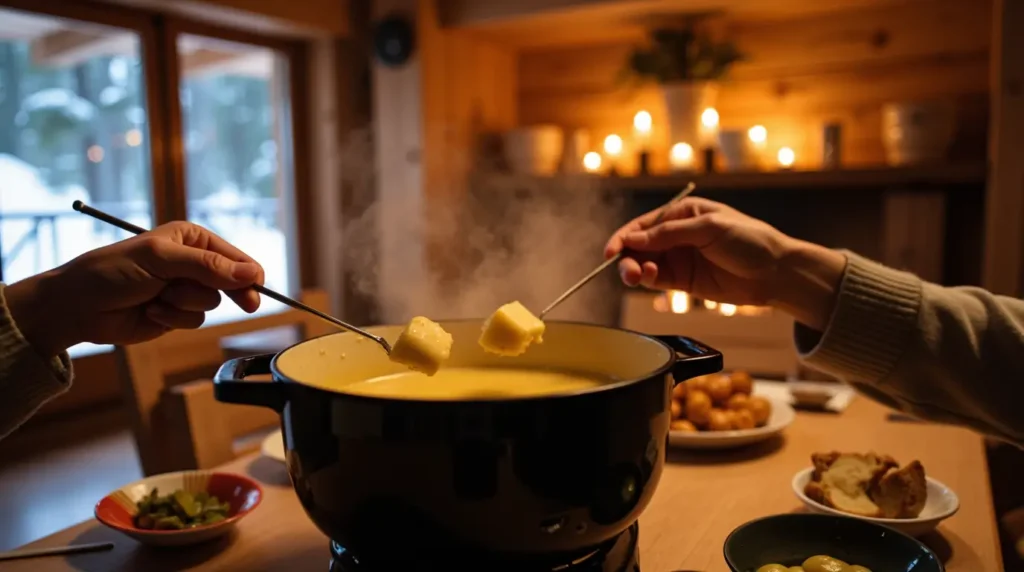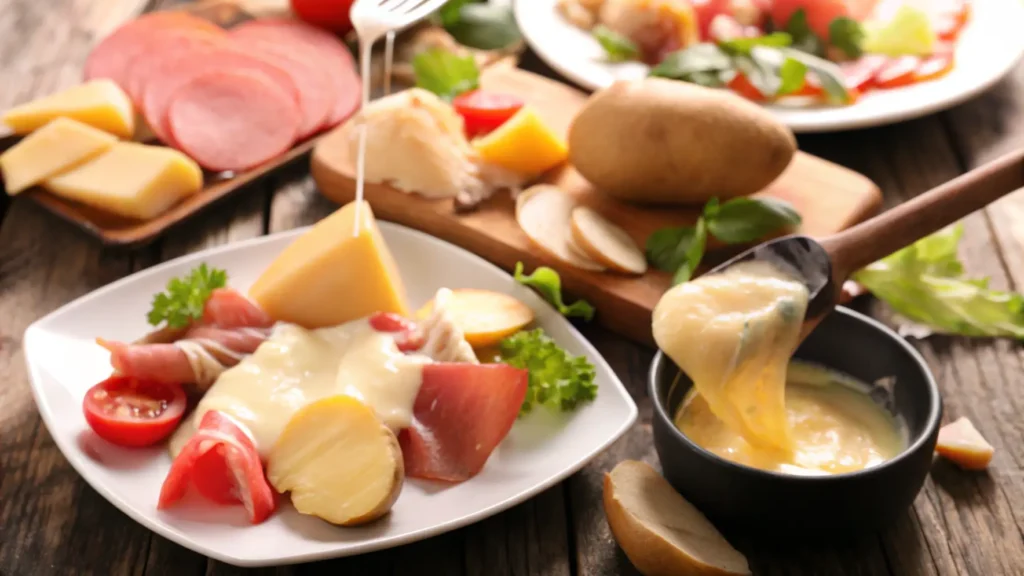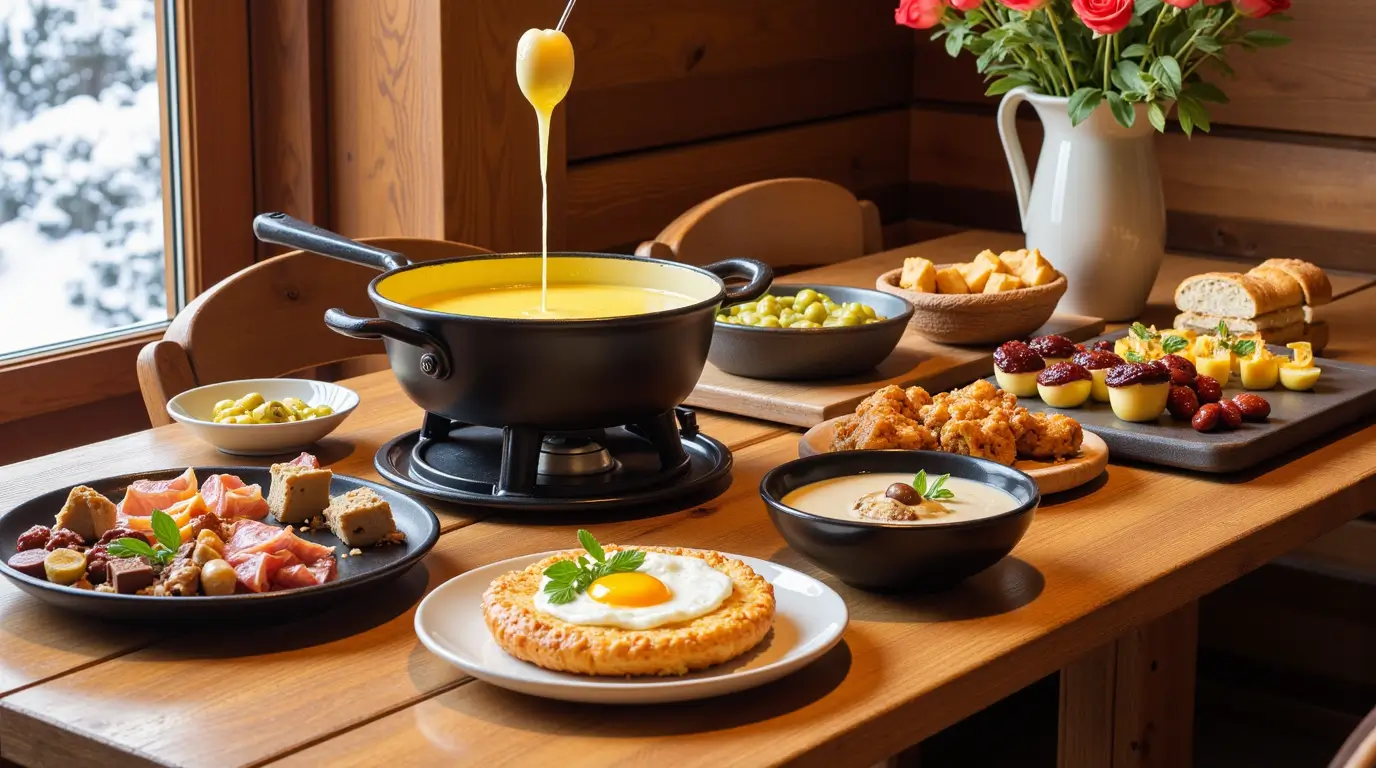Table of Contents
Table of Contents
Introduction
When people think of Switzerland, they often imagine majestic mountains, pristine lakes, and world-renowned chocolate. Yet there is another vibrant aspect of Swiss life that deserves attention: Swiss cuisine. Blending influences from neighboring countries, shaped by the Alpine climate, and enriched by a tradition of artisanal craftsmanship, Swiss cuisine is a rich tapestry of flavors waiting to be discovered. From hearty mountain fare to elegant pastries, it’s a culinary journey that reflects the country’s diverse regions as well as its historical and cultural evolution.
In this article, we delve into every facet of Swiss cuisine—from its foundations in humble countryside dishes to its modern innovations in the gastronomic scene. You will discover how Switzerland’s geography and history have influenced the local palate, learn about key ingredients and where to find them, and explore must-try dishes along with simplified recipes. We will also highlight regional differences that make this cuisine so exciting, outline table rituals and customs, and discuss modern trends propelling Swiss cuisine into the future. Whether you are a seasoned foodie or a curious traveler, Swiss cuisine offers delightful surprises at every turn.
By understanding the historical and cultural contexts that give Swiss cuisine its identity, you will gain deeper appreciation for how a simple dish of potatoes and melted cheese can be elevated to an art form. We will also shed light on some of the country’s best-kept secrets: the variety of local cheeses, the intricacies of mountain herbs, and the seasonality that adds fresh vibrancy to every dish. Ultimately, this guide will equip you with insights, anecdotes, and tips to help you savor all that Swiss cuisine has to offer.
Culinary Context and History
A Multi-Faceted Culinary Legacy
Switzerland’s culinary heritage has been shaped by multiple influences over time. While the country is geographically small, it is culturally diverse, with four main linguistic regions—German, French, Italian, and Romansh—each contributing to local gastronomic identity. Over centuries, Switzerland has taken cues from its neighbors—France, Germany, Italy, and Austria—while also developing its own distinct traditions. As a result, Swiss cuisine cannot be reduced to a single style; rather, it is an amalgamation of various flavors, techniques, and cultural heritages.
Historically, Swiss cuisine grew from pastoral roots. Dairy farming thrived in the Alps, so cheese and butter became staples. Alpine valleys, known for their harsh winters, fostered reliance on preserved foods such as dried meats and fermented vegetables. Meanwhile, trade routes passing through the Swiss Alps introduced a variety of ingredients—spices, coffee, and even cocoa beans—allowing Swiss gastronomy to evolve well beyond pastoral basics.
Impact of Trade and Migrations
Throughout the Middle Ages, Switzerland’s strategic location made it a hub for commerce. The transalpine routes allowed the Swiss to participate in spice trade networks that connected Europe with the Middle East and Asia. Though Switzerland was not colonizing distant lands, it benefited from cultural and commercial exchanges that brought in exotic spices such as cinnamon, nutmeg, and black pepper. Migrations into Switzerland, particularly from Italy, influenced not only the language but also the cooking styles, introducing pasta and polenta to certain regions.
In modern times, international migrations and tourism have continued to enrich Swiss cuisine. Today, you’ll find specialty restaurants serving everything from Mediterranean dishes to Asian fusion. Meanwhile, local Swiss chefs reinterpret and refine these new influences, fusing them with traditional elements to create innovative gastronomic experiences.
Key Periods and Events
- Middle Ages: Switzerland’s emergence as a Confederation opened trade routes. Spices and new products became available, subtly transforming local diets.
- Renaissance to 18th Century: Culinary techniques refined in Europe spread to Switzerland’s wealthy urban centers, particularly Bern and Geneva. Still, much of the rural population remained reliant on simple, hearty fare.
- 19th Century: Industrialization and the establishment of railroads facilitated faster movement of goods, enabling ingredients like sugar and wheat flour to reach remote Alpine areas more easily. This era also saw the rise of chocolate manufacturing, laying the groundwork for the global reputation of Swiss chocolate.
- 20th Century to Present: Increased global connectivity and tourism continue to shape Swiss cuisine. The rise of high-end dining, farm-to-table movements, and organic agriculture has fused tradition with modern health and sustainability concerns.
Regional Culinary Differences
Despite Switzerland’s small size, its culinary map is remarkably diverse. The German-speaking region (central and eastern Switzerland) is known for dishes akin to neighboring Bavaria, such as sausages, rosti (grated potato dish), and hearty stews. In the French-speaking west (Romandy), you’ll encounter a refined cuisine with influences from Burgundy and Savoy—think delicate sauces and a focus on wine pairing.
Southern Switzerland, largely the canton of Ticino, carries a strong Italian influence with dishes like risotto, polenta, and hearty minestrone soups. Finally, in the southeastern canton of Graubünden—home to the Romansh language—cuisine is strongly tied to mountainous traditions, featuring barley soup, cured meats, and nut tarts. These regional variations are essential to appreciating the breadth of Swiss cuisine and underscore why one cannot define Swiss cuisine in simple, singular terms.
Key Ingredients and Local Products
Cheese, the Backbone of Swiss Cuisine
No discussion of Swiss cuisine would be complete without delving into the country’s cheese culture. The lush Alpine pastures and meticulous dairy traditions have produced some of the world’s most famous cheeses, such as Gruyère, Emmental, Appenzeller, and Raclette. These cheeses are integral to iconic Swiss dishes like fondue and raclette. They are also enjoyed in simpler forms, such as sliced on a piece of fresh bread for breakfast or served as part of a cheese platter with dried fruits and nuts.
When selecting cheese for your Swiss culinary explorations at home, prioritize artisanal varieties from specialty cheese shops or look for Swiss AOP (Appellation d’Origine Protégée) labels that guarantee quality and authenticity.
Meats and Charcuterie
Switzerland’s mountainous terrain is conducive to raising cattle, sheep, and goats, which yields not only dairy products but also exceptional meat. Swiss sausages, such as Cervelat, are popular for grilling. In Graubünden, you’ll find Bündnerfleisch, an air-dried beef delicacy with a unique flavor from the pure Alpine air. The country’s charcuterie tradition includes diverse cured meats and salamis, reflecting centuries of preserving techniques. These products can often be purchased at local markets, directly from farms, or at dedicated gourmet stores that specialize in Swiss regional products.
Seasonal Vegetables and Fruits
Seasonality plays a huge role in Swiss cuisine. In spring and summer, Alpine fields and valleys produce a variety of vegetables and herbs: asparagus, wild garlic, spinach, lettuce, chard, parsley, chives, and more. Autumn sees the harvest of pumpkins, root vegetables, and orchard fruits like apples, pears, and plums. For Swiss home cooks, using fresh, locally grown produce is paramount. It not only ensures flavor but also aligns with a sustainable, eco-friendly mindset that has long been cherished in Switzerland. Many cities host weekly farmers’ markets where you can find seasonal produce directly from local growers, making it easy for visitors to shop and experience the best of Swiss agriculture.
Grains and Starches
Potatoes are a cornerstone of Swiss cuisine, featuring prominently in dishes like rosti, raclette accompaniments, and comforting soups. Corn and polenta are especially common in Ticino, reflecting the Italian influence. Traditional bread varieties, such as Zopf (a plaited loaf typically enjoyed on Sundays), rye bread, and artisanal sourdoughs, remain beloved staples across the country. If you want to replicate these breads at home, look for Swiss flour, which can often be found in specialty stores or ordered online.
Herbs, Spices, and Flavorings
While Swiss cuisine is not typically associated with hot spices, herbs and aromatic blends play a crucial role. Alpine herbs—such as thyme, rosemary, and mountain savory—imbue dishes with a distinct floral and earthy essence. Salt from Swiss salt mines (like the saline located in Bex in the canton of Vaud) is sometimes promoted as a local specialty. Condiments like mustard, horseradish, and pickled vegetables also add piquancy, balancing the richness of cheese and dairy-heavy recipes.
In short, the ingredients that define Swiss cuisine are derived from the country’s robust local agriculture, dairy production, and artisanal food traditions. For those eager to recreate Swiss cuisine at home, local markets, specialty grocery stores, and online distributors offer many authentic products. Remember to seek out Swiss AOP labels, shop seasonally, and embrace the essence of freshness that characterizes so many dishes.
Must-Try Traditional Dishes
Cheese Fondue

One of the crown jewels of Swiss cuisine, cheese fondue symbolizes everything Swiss: communal dining, high-quality cheese, and a penchant for hearty warmth during cold Alpine winters. While there are numerous regional variations, the most iconic includes Gruyère and Vacherin Fribourgeois melted with white wine, garlic, and a touch of cornstarch. Served in a communal pot (caquelon), each diner dips cubes of crusty bread into the molten cheese.
History and Origins
Cheese fondue as we know it today became widely popular in the 20th century, but it has roots in rural Alpine communities, where farmers would melt leftover cheese with wine to create a satisfying meal. The Swiss Cheese Union (Schweizer Käseunion) heavily promoted fondue in the 1950s as a national dish, making it a cornerstone of Swiss culinary identity.
Recipe Tips
- Rub Garlic: Cut a garlic clove in half and rub the inside of your fondue pot for subtle flavor.
- Melting Cheese: Warm the wine gently before adding grated cheese and cornstarch. Stir continuously in a figure-eight motion to prevent burning.
- Served with Bread: Traditionally, day-old bread is preferred for its firmness. Optionally, serve small boiled potatoes, pickled onions, or gherkins on the side.
Raclette

Raclette is another must-try dish that perfectly showcases the country’s cheese heritage. Traditionally from the Valais region, Raclette is a semi-hard cheese heated until it begins to melt and is then scraped onto a plate of boiled potatoes, pickles, and onions. Modern Raclette grills or table-top machines have made the process more interactive and entertaining, allowing each guest to melt their slice of cheese to personal preference.
Variations
- Valais vs. Other Regions: The original Valais Raclette often features raw-milk cheese, offering a more intense flavor profile. Elsewhere, factory-produced Raclette cheese might have milder flavors.
- Add-Ons: Beyond pickles and potatoes, diners can add dried meats or vegetables.
Rösti

A humble yet iconic Swiss dish, rösti is made by grating potatoes, shaping them into a disc, and frying them in butter or oil until crispy. Originally a farmers’ breakfast in the Bern region, rösti has become a national favorite, served as a side dish or even as a main course topped with melted cheese, fried eggs, or bacon. Regional twists exist, with some cooks adding onions, herbs, or even grated apples to the potato mixture.
Simple Rösti Recipe
- Ingredients: 3 large potatoes (preferably waxy), salt, pepper, and butter for frying.
- Preparation: Parboil the potatoes until just tender, then let them cool and grate them coarsely.
- Cooking: Heat butter in a skillet, add grated potatoes, and press them down. Cook until golden, then flip or slide onto a plate and invert back into the skillet to brown the other side.
- Serving: Accompany rösti with fried eggs, smoked salmon, or a dollop of sour cream.
Chocolate and Confectionery

While not a single dish, Switzerland’s global reputation for chocolate deserves highlighting. Brands like Lindt, Toblerone, and Cailler have become household names worldwide. Swiss chocolate makers perfected the art of conching and milk-chocolate production, leading to a silky, melt-in-the-mouth texture. On a local level, artisanal chocolatiers craft specialty bars, pralines, and truffles that elevate chocolate to a gourmet experience.
Visiting a Chocolate Shop
For an immersive experience, visit a local chocolatier in cities like Zurich, Geneva, or Lucerne, and witness the craftsmanship behind each truffle or bar. Some chocolate shops offer workshops where you can learn basic techniques and create your own custom confections.
These dishes—fondue, raclette, rösti, and premium Swiss chocolate—merely scratch the surface of Swiss cuisine. Nonetheless, they epitomize the comfort, communal spirit, and respect for quality ingredients that define Swiss cooking.
Defining Characteristics of Swiss Cuisine
Swiss cuisine can be described as hearty yet refined, offering a balance between rustic mountain fare and sophisticated culinary techniques absorbed from its neighbors. It is neither overly spicy nor excessively sweet; instead, it focuses on the natural flavors of fresh ingredients. Dairy products, particularly cheese, bring a creamy richness, while herbs and mild spices contribute to the nuanced taste profile.
A few features make Swiss cuisine distinctly appealing:
- Quality and Freshness: Strict regulations and a culture of pride in artisanal production ensure top-notch ingredients.
- Alpine Herbs and Seasonings: Typical seasonings are mild, focusing on the aroma of herbs like thyme, rosemary, and chives, rather than on intense heat or strong spices.
- Cheese and Chocolate Culture: The Swiss devotion to perfecting cheese and chocolate has become a hallmark of their cuisine.
- Regional Diversity: Each linguistic region brings its own flair—French-inspired sauces, Germanic sausages, Italian polenta, and Romansh mountain dishes, all under the umbrella of Swiss flavors.
For food enthusiasts seeking new experiences, Swiss cuisine offers an intriguing journey—one that features comforting flavors, subtle complexity, and an emphasis on conviviality. It is perfect for those who want a break from heavily spiced dishes but still crave rich, savory tastes and artisan craftsmanship.
Tips and Highlights to Encourage People to Try This Cuisine
- Variety of Flavors: From creamy fondues to refreshing Alpine salads, there is a broad spectrum that caters to different palates.
- Cultural Immersion: Enjoying Swiss cuisine is also about experiencing Swiss hospitality and picturesque settings—think a rustic chalet with mountain views.
- Easy Adaptability: Many Swiss recipes, such as rösti or fondue, are straightforward to prepare at home.
- Stories and Heritage: Switzerland’s culinary traditions are steeped in history. Delve into local tales of herders making cheese high in the Alps, or learn how modern Swiss chocolatiers constantly innovate while preserving old-world craftsmanship.
- World-Class Products: Swiss cheeses and chocolates consistently rank among the best in the world, making them must-try items for any food lover.
An anecdote often shared: on a chilly evening, families or friends gather around a fondue pot, sharing not just a meal but stories, laughter, and a sense of cozy togetherness. This spirit of unity and enjoyment is integral to Swiss dining culture and leaves a lasting impression on visitors.
Table Rituals and Customs
Typical Meals
- Breakfast (Zmorge/Le Petit Déjeuner/Colazione): Often a simple affair of bread, butter, jam, cheese, or muesli (a Swiss invention by Dr. Maximilian Bircher-Benner). Locally roasted coffee or hot chocolate is a staple, reflecting the Swiss love for quality beverages.
- Lunch (Mittagessen/Déjeuner/Pranzo): Traditionally the main meal of the day in rural areas. You might find soups, pasta, or a meat dish with vegetables, although modern work culture has shifted to quicker lunches—salads, sandwiches, or light hot dishes.
- Afternoon Snack (Zvieri/Le Goûter/Merenda): Many Swiss enjoy a small snack, which could be bread with cheese or cold cuts, fruit, or pastries.
- Dinner (Abendessen/Dîner/Cena): Often lighter than lunch, featuring dishes like raclette, fondue, or a simple salad with bread. However, weekend dinners can be more elaborate, especially if entertaining guests.
Table Etiquette
Swiss dining etiquette is generally polite and understated. Some customs to note:
- Greetings: Wait to be shown your seat if you are a guest. A pleasant “En Guete!” in German, “Bon appétit!” in French, or “Buon appetito!” in Italian is always appreciated before starting a meal.
- Pace of Dining: Meals can be leisurely, especially dinner. Swiss appreciate taking time to savor food and converse.
- Knife and Fork: The Swiss follow the European style of keeping the fork in the left hand and the knife in the right while eating. Rest utensils on your plate in a parallel position to indicate you are finished.
- Tipping: Service is often included in the bill, but rounding up or leaving a small tip is common practice to show appreciation.
Festive Occasions and Food
Swiss national holidays, local fairs, and religious events come with their own culinary traditions:
- Swiss National Day (August 1): Communities gather for barbecues, bonfires, and fireworks. Typical foods include sausages, bread, cheese, and local specialties.
- Christmas Season: Stollen (a fruit bread more common in German regions), Christmas cookies (known as Guetzli in German-speaking parts), and mulled wine or hot chocolate are widely enjoyed.
- Carnival (Fasnacht/Carnaval/Carnevale): Occurs before Lent. Some regions have special pastries or donuts (Faschnachtschüechli) to mark the festivities.
- Alpine Descent (Alpabzug): When cows come down from the high pastures in autumn, villages often celebrate with cheese tastings and local produce markets.
Experiencing these traditions offers a window into how Swiss cuisine weaves into the social and cultural fabric of the country. Whether you’re invited to a family dinner or attending a local festival, each gathering exemplifies the Swiss ethos of quality, conviviality, and respect for tradition.
Modern Trends and Culinary Fusions
Global Influences and Fusion Cuisine
Contemporary Swiss cuisine continues to evolve, absorbing elements from Asia, the Americas, and other parts of Europe. Chefs who have traveled abroad bring fresh concepts and ingredients back home, experimenting with everything from sushi-inspired techniques to Latin American spices. In cities like Zurich, Geneva, and Basel, you’ll find restaurants blending Swiss products (like local fish and cheese) with exotic seasonings and preparations.
New Consumption Trends
The modern Swiss are increasingly mindful of nutrition, sustainability, and animal welfare. This is reflected in the rise of:
- Farm-to-Table: Many restaurants now source their produce, meat, and cheese directly from Swiss farmers, ensuring fresh, local, and organic ingredients.
- Vegetarian and Vegan Offerings: While cheese still dominates, more eateries are offering plant-based alternatives, reflecting a growing global trend. Raclette and fondue restaurants might have vegan cheese options, and creative chefs experiment with vegetable-forward menus using mushrooms, lentils, and ancient grains.
- Organic Food Markets: Bio (organic) certifications are highly valued in Switzerland, and numerous markets specialize in clean, sustainable produce.
Innovative Chefs and Young Restaurateurs
A new generation of Swiss chefs is reinterpreting traditional dishes, bridging the gap between heritage and modernity. For instance, you might find a minimalist take on rösti served with truffle oil or a deconstructed fondue that plays with different cheese foams and textures. High-profile examples include restaurants in major Swiss cities that have earned Michelin stars for their creative approach to melding local traditions with international flair. These chefs champion transparency in sourcing, artisanal techniques, and an artistic presentation that elevates classic dishes.
Such developments ensure Swiss cuisine remains dynamic and relevant, appealing both to those seeking comfort in time-honored recipes and to foodies in search of new gastronomic frontiers.
Conclusion and Call to Action
Swiss cuisine, shaped by its Alpine geography and enriched by cultural exchanges with neighboring regions, showcases a remarkable breadth of flavors and traditions. From iconic cheese dishes such as fondue and raclette to the beloved rösti and artisanal chocolates, the gastronomic world of Switzerland is far more complex than it may appear at first glance. Each canton offers a taste of its own heritage, whether that involves hearty mountain stews, Italian-influenced polenta, or delicate French-style desserts. Modern Swiss chefs fuse these traditions with global influences, reflecting a spirit of innovation that continues to propel Swiss cuisine forward.
As you explore the nuances of Swiss cuisine—whether by traveling through Switzerland or recreating dishes at home—consider the emphasis on quality, seasonality, and artisanal craftsmanship that permeates everything from cheese-making to bread-baking. We encourage you to share your own experiences: Have you tried making fondue at home? Discovered a hidden gem of a chocolate shop in a Swiss village? Or perhaps you have questions about sourcing the best raclette cheese? Let us know, and join the conversation celebrating this unique culinary tapestry.
Finally, to keep our journey alive, stay tuned for a future article where we delve into the wide variety of Swiss pastries and baked goods, from butter-rich Zopf bread to delicate Luxemburgerli macarons. Until then, immerse yourself in the comfort, heritage, and innovation of Swiss cuisine—a dining experience that embodies the very essence of Switzerland’s stunning landscapes and warm hospitality.

